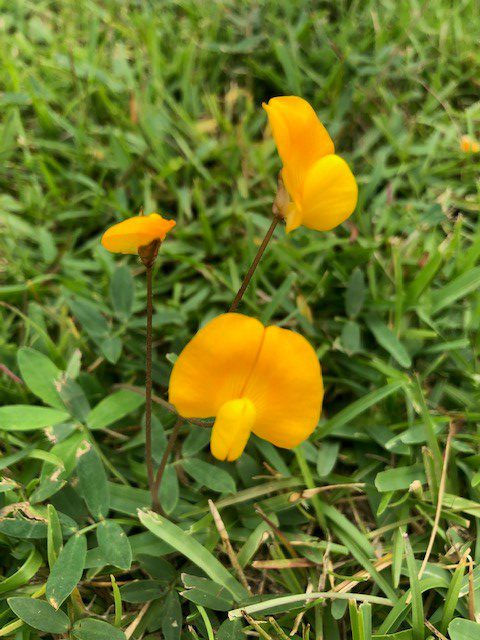
by Carrie Stevenson | Jul 2, 2020
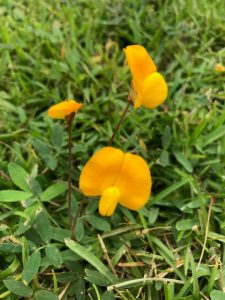
The bright yellow perennial peanut flower is not only pretty, but edible! Photo credit: Carrie Stevenson, UF IFAS Extension
It’s bright yellow, makes its own fertilizer, and tastes like peanut butter. On my morning walks around the track at our office, I have noticed lately that the perennial peanut (Arachis glabrata) is growing lushly, fulfilling its role as a low maintenance groundcover. The plant thrives in hot weather, full sun, and humidity, so we have nearly reached peak growing conditions for this South American native.
Perennial peanut was brought in from Brazil almost 90 years ago as a valuable hay crop and livestock forage. It is still used regularly for these purposes. However, as years of experience have borne out, there are no insect, disease, or unwanted invasive issues with the plant. The lush green groundcover has been used in the past few decades as a popular turfgrass alternative. It is drought and salt tolerant, and can thrive in low-nutrient, sandy soils.
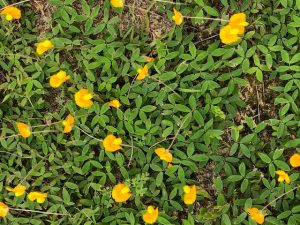
Perennial peanut is a drought-resistant, salt-tolerant, erosion-managing groundcover. Photo credit: Carrie Stevenson, UF IFAS Extension
Its bright yellow blossoms are delicate and almost orchid-like in shape, standing upright on a thin stem. As mentioned earlier, the flower is also edible and has a very light peanut flavor. The foliage, a deep green with compound leaves, lies close to the ground. Its spreading rhizomes serve as an excellent erosion control method, holding even easily washed out sandy soils in place.
Like its more well-known cousin, the perennial peanut is a legume, which means it can “fix” atmospheric nitrogen, transforming it into a form the plant can use. For a homeowner, this means you do not need to add nitrogen fertilizer. If phosphorus levels are naturally high enough in the soil (as is often the case in south Florida), only small amounts potassium-magnesium sulfate may be needed.
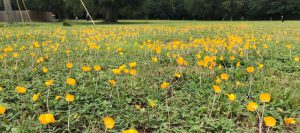
Perennial peanut is a great choice in open areas. Photo credit: Carrie Stevenson, UF IFAS Extension
Perennial peanut is best utilized in open spaces without high foot traffic. If you’d like to see it, come out to the Escambia Extension office; there’s a large swath of it between our main building and the demonstration garden near the walking path. If you are interested in planting or maintaining it, check out these documents from UF IFAS Extension or watch this informative video from a colleague!
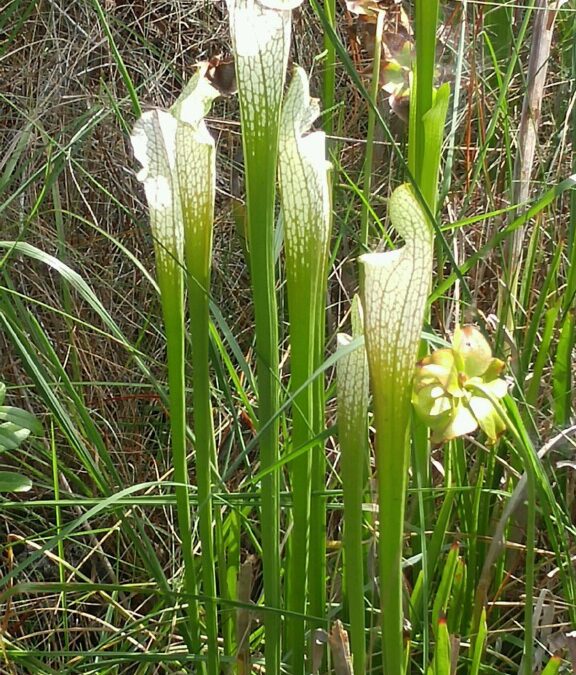
by Carrie Stevenson | Apr 30, 2020
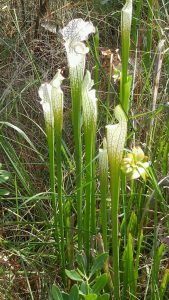
White-topped pitcher plants in bloom at Tarkiln State Preserve. Photo credit: Carrie Stevenson, UF IFAS Extension
If you live in northwest Florida or southeast Alabama and have never laid eyes on our wild native carnivorous plants, it is about time! April and early May are the best time to see them in bloom. We have six species of pitcher plants (Sarracenia), the most common being the white-topped (Sarracenia leucophylla). However, they come in multiple colors, from yellow and red to a deep purple, and in different sizes.
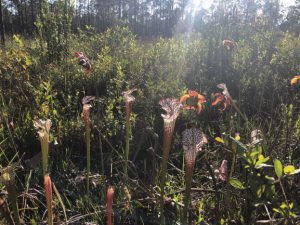
Pitcher plants and their pinwheel-shaped flowers at Splinter Hill Bog. Photo credit: Carrie Stevenson, UF IFAS Extension
One thing they have in common, though—they eat meat. Carnivorous plants all over the world have evolved in places that left them few other options for survival. These plants are typically found in extremely wet, acidic, mucky soils with very low nutrient levels. Normally, plants uptake nutrients like nitrogen and phosphorus from the soil around them. Not being available in these particular environments, carnivorous plants (or more specifically, insectivorous) developed a way to extract nutrients from insects.
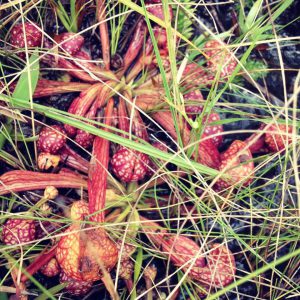
Small parrot pitcher plants lie on the ground instead of standing upright at Blackwater State Forest. Photo credit: Carrie Stevenson, UF IFAS Extension
So how does it work? Pitcher plants have a modified leaf, which instead of lying out flat like most plants, is rolled up into a tube, or “pitcher” shape. The inside of the pitcher has a sweet sap, and the walls of the tube are lined with tiny, downward-pointing hairs. Separate from the leaf, the plant has an elaborate flower structure, which attracts insects for pollination. While nearby, these insects are also attracted to the colorful leaf and the sweet sap in its pitcher. The insect will land on the lip of the leaf, then crawl down.
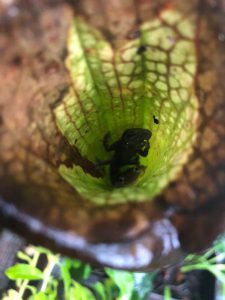 Those sticky, downward facing hairs are a trap, preventing insects from leaving the pitcher. Enzymes—a cocktail of proteins naturally found in many other plants but used creatively here—in the sap break down the bug bodies and convert them to nutrients for the plant. In fact, if you slice a cross-section into a pitcher wall or break open a dried one, you will see countless dried exoskeletons at the bottom of the tube. Several other enterprising species have taken advantage of the pitcher plant’s creative structure. More than once, I have seen tiny spiders spin webs across the mouth of the tube, or small lizards and frogs at the bottom, waiting patiently for prey.
Those sticky, downward facing hairs are a trap, preventing insects from leaving the pitcher. Enzymes—a cocktail of proteins naturally found in many other plants but used creatively here—in the sap break down the bug bodies and convert them to nutrients for the plant. In fact, if you slice a cross-section into a pitcher wall or break open a dried one, you will see countless dried exoskeletons at the bottom of the tube. Several other enterprising species have taken advantage of the pitcher plant’s creative structure. More than once, I have seen tiny spiders spin webs across the mouth of the tube, or small lizards and frogs at the bottom, waiting patiently for prey.
Some of the best places to see pitcher plants in the area—they also bloom in October—are Tarkiln Bayou State Preserve, Weeks Bay National Estuarine Research Reserve, Splinter Hill Bog Preserve, and Blackwater State Forest.
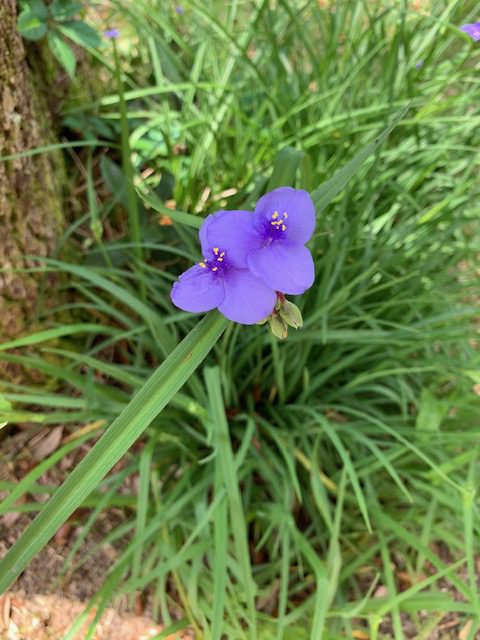
by Carrie Stevenson | Apr 24, 2020
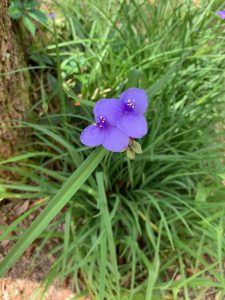
The brilliant purple, edible spiderwort flowers are only around for a day! Photo credit: Mary Anne Tomlinson
The spiderwort is a pretty little plant that most people have encountered in their yards or on roadsides. In cattle or hay pastures, it is considered a weed because cows won’t eat it, and its high moisture content can ruin hay harvests. In a home landscape, though, it can be a nice addition to the yard. I know many homeowners who refuse to let them be mowed down with the lawn simply because of their brilliant color. The native spiderwort (genus Tradescantia) is a perennial flower that grows in clusters, often in moist soils. It is a member of the dayflower family, which means each flower is only open for a single day. The plant, a favorite of bumblebees, can be identified quickly by its triad of violet petals and bright green, strap-like leaves.
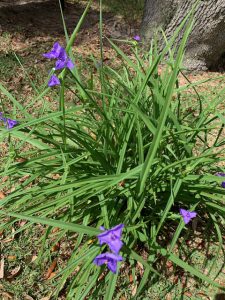
Spiderworts bloom in spring and grow in clumps of bright green, strappy leaves. Photo credit: Mary Anne Tomlinson
Known by common names as varied as “Bluejacket,” “Snotweed,” and “Cow Slobber” (due to the mucilaginous—mucus-like–consistency of its sap), the plant is widespread throughout the eastern and central United States. An interesting aspect of this sap is that it can be used as a salve for insect bites, similarly to aloe. Even more useful for those interested in native edible plants is that the flowers, stems, and leaves can be eaten raw in a salad or cooked and used as a culinary herb. The flowers can be candied with sugar as a dessert or used atop cakes.
Interestingly, the spiderwort can also indicate the presence of radiation. The bluish hairs on spiderwort flower stamens will turn pink in the presence of low levels of radiation, often more reliably than mechanical dosimeters.
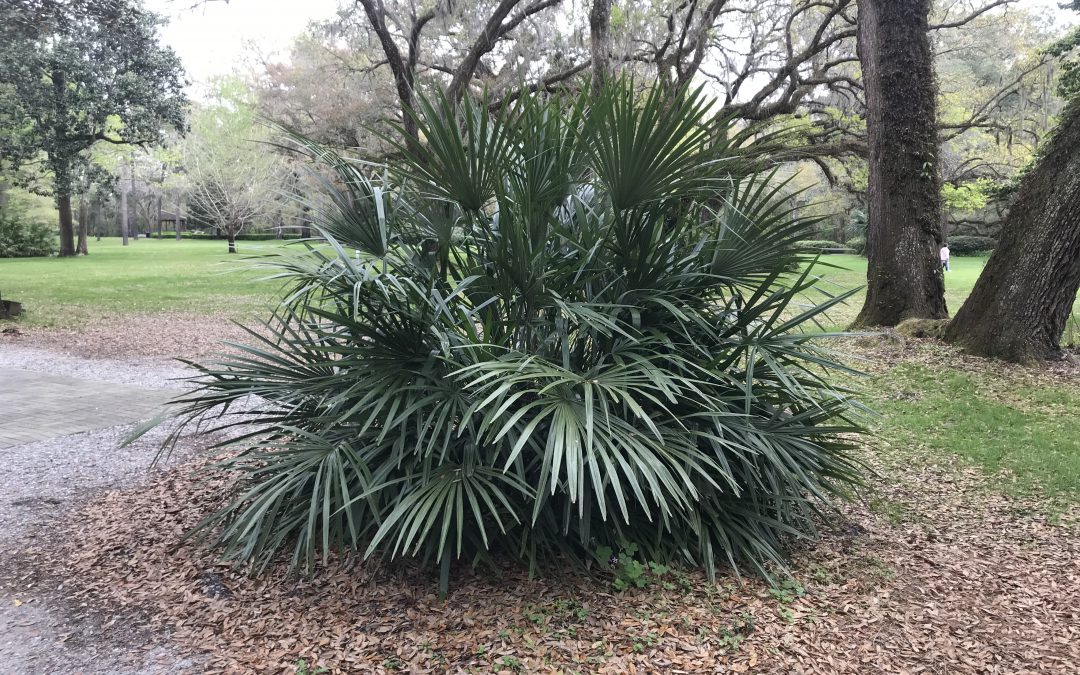
by Daniel J. Leonard | Apr 9, 2020
There aren’t a lot of quality landscape plant options that fit the description nearly every homeowner desires: native, low-maintenance, slow-growing, pest free, drought tolerant while tolerating wet soils, loving both sun or shade, and green year-round. Needle Palm (Rhapidophyllum hystrix) is the rare plant that checks all those boxes and deserves consideration when adding plants to your landscape!
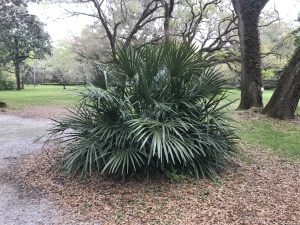
Mature Need Palm at Eden Gardens State Park in Walton County. Photo courtesy the author.
Needle Palm is an endangered native, growing in a narrow range in the coastal Southeastern US, Calhoun and Liberty counties included. It is primarily found in the understories of wet wooded areas along slopes, ravines, and bottoms; if you’ve ever hiked the Apalachicola Ravines or Torreya State Park trails, you’ve likely encountered Needle Palm in the wild! Being native is nice, but what makes Needle Palm an outstanding landscape option?
Needle Palm is the prettier, more refined cousin of Saw Palmetto (Serenoa repens), which it is sometimes confused with. Unlike the rambling, aggressive, stiff-leaved palmetto, Needle palm possesses “softer”, finely cut, lustrous evergreen leaves, allowing it to add amazing texture to any landscape. Also, unlike palmetto, it doesn’t need a yearly “cleaning” to prune out brown, dead leaves, rather its leaves persist green and clean for many years! You might not want to reach into the interior of a Needle Palm plant anyway, as generally unseen 6-8” namesake “needles” surround the base of its trunk. Needle Palm grows very slowly, eventually reaching 8’ tall or so, but is more often seen in the 4-6’ range in landscapes. This is absolutely a shrub that will never outgrow its welcome. It is a nearly trunkless palm, almost always appearing as a shrub, though with extreme old age it can begin to look a bit like a small tree with a muted trunk. With outstanding aesthetics and a low-maintenance growth habit, Needle Palm has a place in nearly any landscape.
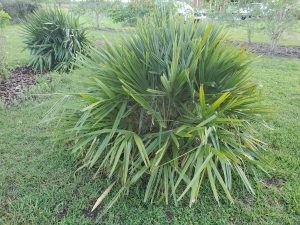
6 year old needle palm grouping growing in author’s landscape.
In the landscape, Needle Palm does best when sited with some shade in the afternoon but also thrives in full sun. They appreciate regular water during establishment but survive on their own without any extra irrigation after! Needle Palm also doesn’t need much in the way of supplemental fertilization. They do look their best with a light spring application of a general purpose, slow-release fertilizer, but this is not required. Needle Palms are not afflicted with the pest and pathogen problems the much more commonly used non-native Sago Palms (Cycas revlolutas) attracts. I’ve grown Needle Palm for 6 years in the landscape and have never noticed any pest or disease issues. With Needle Palms becoming more common in the nursery trade, I don’t see a place in most landscapes for the inferior, high-maintenance, insect infested Sagos. If you want the tropical, textured look of Sagos, plant Needle Palm instead.
Needle Palm is an extremely attractive, low-maintenance Northwest Florida native plant that you should absolutely seek out and add to your landscape! If you want more information or have any questions about Needle Palm or any other landscape/garden topic, please give us a call at the UF/IFAS Calhoun County Extension Office. Happy Gardening!

by Matt Deitch | Mar 13, 2020
Flooding and poor water quality are common issues of concern in the Florida Panhandle. Our frequent heavy rains cause water to quickly run off rooftop, parking lot, and driveway surfaces; this runoff water carries with it the chemicals deposited on land surfaces between rain events by direct application (such as landscape fertilizers) as well as through wind and circulation, a process referred to as atmospheric deposition. Surface water that runs off our developed urban and residential landscape is usually routed into stormwater drains and sewers, and then into stormwater detention ponds or directly into surface streams.
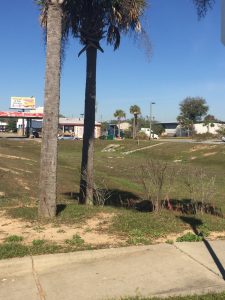
Dry stormwater pond in Escambia County.
Photo: Matt Deitch
Conventional methods for dealing with stormwater runoff is through the use of stormwater ponds. Stormwater ponds allow water to slowly infiltrate into the soil before moving to streams or wetlands via shallow groundwater pathways. Typically hidden behind shopping centers or in the back of residential subdivisions, stormwater ponds attenuate flooding by delaying the time when water reaches the stream and are intended to improve water quality through microbial processes (such as denitrification) or plant uptake, particularly focusing on reducing the amount of nitrogen and phosphorus that reaches nearby streams. However, the efficacy of stormwater ponds is highly variable (many do not function as intended), and they often are visually unattractive aspects of a community.
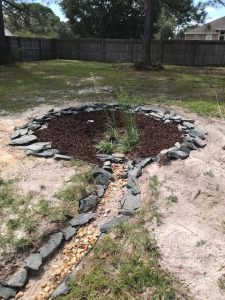
A backyrad rain garden after installation near Navarre FL.
Photo: Nikki Bennett
Stormwater managers in other parts of Florida are increasingly utilizing a suite of management features termed “green infrastructure” as alternatives to stormwater ponds to reduce floodwaters and improve water quality before it enters nearby streams and wetlands. Green infrastructure, which includes features such as rain gardens, green rooftops, rainwater cisterns, bioswales, and permeable pavers, is designed to slow water down and reduce pollutant concentrations by mimicking natural processes of infiltration and biological uptake at its source—off the rooftops, driveways, roads, and parking lots where stormwater first concentrates. As a result, green infrastructure reduces surface runoff that occurs during storm events, leading to less flooding downstream. With the magnitude of peak flow reduced, stormwater runoff is also likely to carry lower amounts of pollutants downstream. In addition to their capacity to reduce flooding and improve water quality, green infrastructure can have many other benefits. It is often visually appealing, with vegetation typically selected to be visually attractive, appropriate for local conditions, and requiring low maintenance.
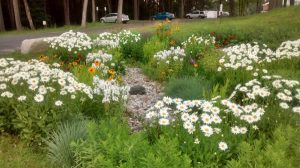
Rain garden at the VA Central Western Massachusetts Health Care System facility.
Photo: US Air Force
With our frequent rainfall, moderately developed urban areas, and expanding communities, the Florida Panhandle is ideal for using green infrastructure to reduce flooding and improve water quality. Features such as bioswales, rain gardens, and permeable pavement can be added to new development to mitigate stormwater runoff; they can also be added to existing neighborhoods to reduce flooding where roadside areas or other shared spaces allow. In addition to mitigating the effects of rainfall, green infrastructure can also improve property values because of their visual appeal. For green infrastructure techniques to be effective, they require widespread use throughout a neighborhood rather than at a handful of locations; so if it sounds like green infrastructure would benefit your community, talk with your neighbors and reach out to UF IFAS agents to discuss how it could be added to your community!
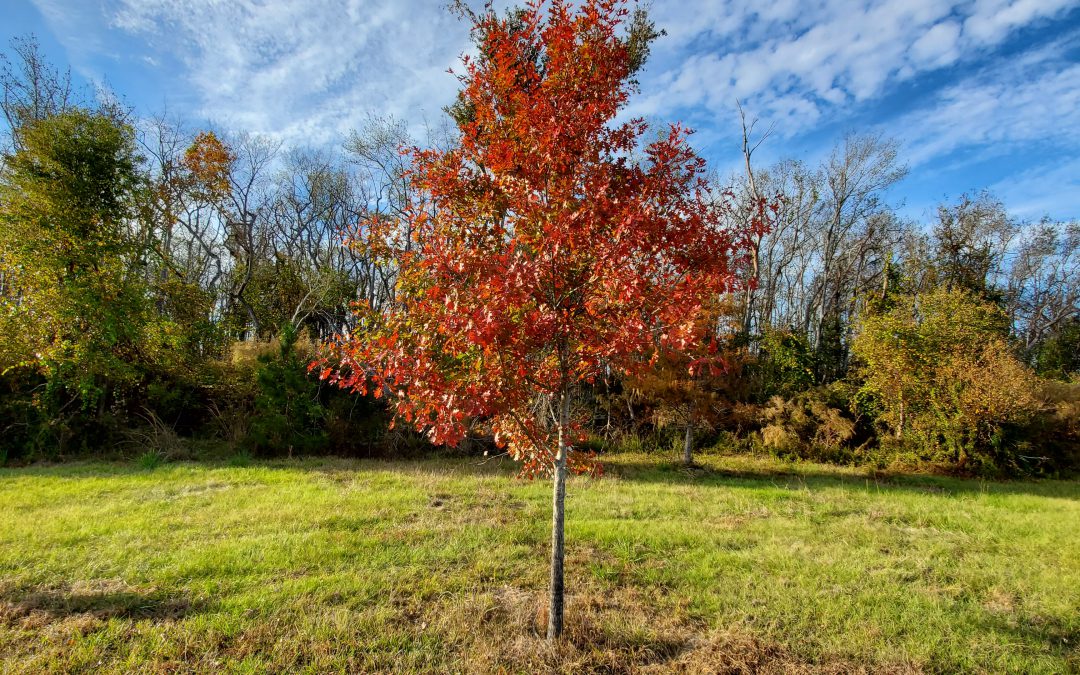
by Daniel J. Leonard | Jan 17, 2020
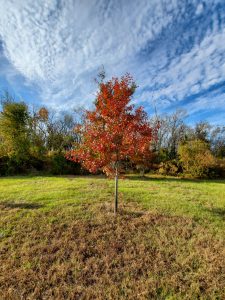
Five Year old Shumard Oak. Photo courtesy the author.
One of the keys to bagging a deer or mess of squirrels or just enjoying an afternoon viewing wildlife is to locate their preferred food source. In the Panhandle, this often means finding a natural stand of oaks or other mast producing trees. However, the concept of attracting animals to mast trees isn’t exclusive to natural areas; it can be replicated by hunters and wildlife enthusiasts to attract whitetail deer, squirrels, turkeys or any other game. (Don’t let the terminology confuse you, “mast” is just a term meaning “fruit from a tree”. “Hard” mast refers to nut producing trees -think Oak, Hickory, etc. Soft mast is just that, soft-fleshed fruits – think Pear, Plum, etc. This piece will focus on hard mast trees.) Regardless of semantics, the takeaway is that planting mast producing trees as winter wildlife attractants have several benefits.
- Enhanced habitat. Planting diverse groups of hard mast producing trees provides wonderful cover for deer to browse, squirrels to nest, and turkeys to roost. Also, groups of trees planted in open areas can help to create desired edge effects, see this publication on benefits of “edge” from Auburn University.
- Excellent nutritional supplement to winter food-plot forages (winter food plots are defined here as open areas planted in the cool season with small forage grains like oats, clover, or ryegrass). If a diversity of species is planted, hard mast trees are an excellent, season-long (approximately October-January) source of proteins and fats. They produce high-energy nutrients deer and other critters need to get through the winter months.
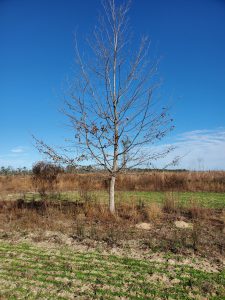
5 year old Sawtooth Oak in December 2019, inter-planted in winter forage plot. Photo courtesy the author.
- Reduction in time and money needing to be spent maintaining annual food plots. A well-designed grove of mast producing trees can be as effective in attracting deer and other animals as winter grazing plots and a whole lot cheaper. A study done by the University of Tennessee Extension in 2008 found that hunters spent about $200 per acre on winter food plots (seed, fertilizer, equipment, time, etc.), an expense that will happen EVERY year. And as many of you know from personal experience, $200 is a VERY conservative number, particularly if you value your personal time at all. Replacing half an acre of cultivated winter forage with mast trees will likely be more expensive in year one when you initially buy and plant but remember, if you do it right, you only have to do it once.
With those benefits of mast trees for wildlife attraction in mind, let’s address what and how to plant. Always select trees with desirable characteristics: long-lived, disease-free, and high-quality mast production at an early age (you don’t want your heirs to get all the benefit!). In the Panhandle, Oaks (Quercus spp.) fit this bill best. There are two groups of Oak to pick from, Red and White. Red Oaks generally have dark, ridged bark, leaves with pointed lobes, small to medium-sized acorns that mature in two seasons, and tend to crop reliably each year. White Oaks possess lighter colored bark, leaves with rounded lobes, large, “sweet” acorns maturing in one season, and tend to produce heavily in alternate years. Plant some of each group to ensure an acorn crop each year and maximize wildlife benefit! However, not just any old oak will do; the Oaks that most closely fit all the above characteristics are:
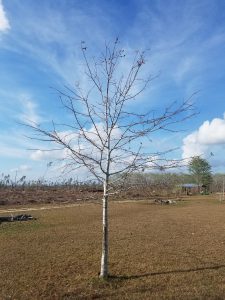
5 year old Nuttall Oak. Photo courtesy the author.
Nuttall Oak (Quercus nuttalli) – Red Oak Group. Rapidly growing, attractive tree, very early producer of good-sized acorns (5-6 years). Drops acorns late, providing needed fats and carbohydrates for bucks through much of the “rut” in the Panhandle (Late November-early February). Tolerates flooding and bottomland areas well.
White Oak (Quercus alba) – White Oak Group. Long-lived, stately tree. Relatively early producer of very large, sweet acorns. Acorn drop is earlier than Nuttall Oak. Grows best on moist upland soils.
Swamp Chestnut Oak (Quercus michauxii) – White Oak Group. Large tree with flaky white/gray bark. Relatively early producer of massive, prized acorns. Acorn drop occurs around the same time as White Oak. Prefers moist upland soils like its cousin the White Oak but will tolerate periodic flooding.
Sawtooth Oak (Quercus acutissima) – White Oak Group. Non-native. Medium-sized tree with heavy branches, often full to the ground. Very early and reliable producer of large, sweet acorns (begins producing at 5-6 years). Begins to drop acorns in September – often the first Oak to produce mast in the season. Grows best on moist upland soils.
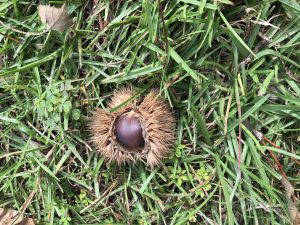
Chinese Chestnut mast in October. Photo courtesy the author.
Chinese Chestnut and Chinese/American Hybrids (Castanea spp.) – Not oaks but worthy of inclusion. Non-native or native hybrids. Medium-sized, spreading trees. Earliest producer of mast (3-4 years from seed germination). Highly sought-after by deer. Tolerates poor soils well but best production is in moist upland areas. I’m particularly partial to the newer American/Chinese Chestnut hybrids like ‘Dunstan’ and ‘AU Buck’.
It is important to remember that success starts at planting. Select healthy container or bare-root trees in the dormant season (December-February) and plant soon after to ensure the rootball doesn’t dry out. Dig planting hole the same depth plants are in containers or to depth of topmost root and backfill with native soil. Do not amend with compost or potting soil! After planting, the trees will need supplemental water, a few gallons per week, unless significant rainfall is received. Water regularly until establishment (when they no longer need your help, generally three-six months after planting).

4′ tree grow tubes are effective at protecting young trees from deer browsing. Photo courtesy the author.
Also, recently planted seedlings will need protection from deer browsing. Unfortunately, deer don’t realize these trees will directly benefit them in a few years and will do their best to destroy them by eating the tender new growth or “rubbing” with their antlers, girdling the trees in the process. I’ve found that either a small 4’ high wire cage held together with zip ties works well, as do plastic grow tubes sold by many wildlife providers. If you opt to use grow tubes, secure them with a substantial staking material such as PVC, always carefully look inside when working around the trees as tubes are magnets for wasp nests, and be vigilant in keeping fire ants out (they enjoy building their homes inside the tree tubes, the nests will often reach several feet up the tube, causing major problems for the tree!) Finally, to maximize growth rate of your trees and expedite the mast-producing process, remove competition from the base of trees by pulling weeds or herbicide application and fertilize regularly (when growth emerges in the spring, again in early summer, and again in late summer to early fall).
As always, if you have any other questions or want more information, contact your local UF/IFAS Extension Office. Happy planting!

























